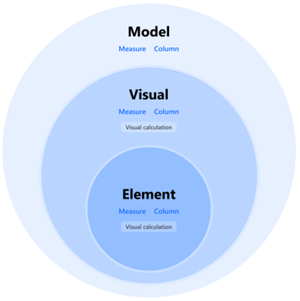Note
Access to this page requires authorization. You can try signing in or changing directories.
Access to this page requires authorization. You can try changing directories.
APPLIES TO:
Power BI Desktop
Power BI service
With custom format strings in Power BI Desktop, you can customize how fields appear in visuals and make sure your reports look just the way you want them to.
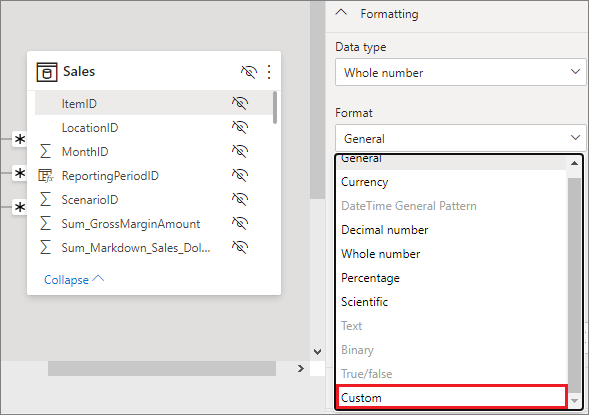
Format strings exist on three levels:
- Model. You can set a format string for fields in the model or use a dynamic format string to format your measure. Anywhere you use that field the format string is applied, unless overridden by a visual or element level format string.
- Visual. You can set format strings on any column, measure, or visual calculation that is on your visual, even if they already had a format string. In that case the model level format string is overridden, and the visual level format string is used. If you change the aggregation on a field, which invalidates a previously set visual level format string, the format string is removed. Visual level format strings for fields are persisted for fields, but not for visual calculations. If you set a visual level format string on a field and then remove and readd that field to the same visual, the visual level format string is reinstated. In contrast, for a visual calculation, the format string isn't reinstated.
- Element. You can set a format string for data labels and for specific elements of the new card and the new slicer visuals. This level will be expanded to include more in the future. Any format string you set here overrides the format string set on the visual and model level.
These levels are hierarchical, with the model level being the lowest level and the element level the highest. A format string defined on a column, measure, or visual calculation on a higher level overrides what was defined on a lower level.
Since visual calculations aren't in the model, they can't have a format string set on the model level but can on the visual, or element level. Measures and columns can have format strings on all three levels:
| Level | Impacts | Available for |
|---|---|---|
| Element | Selected element of the selected visual | Measures, Columns, Visual Calculations |
| Visual | Selected visual | Measures, Columns, Visual Calculations |
| Model | All visuals, all pages, all reports on the same model | Measures, Columns |
The element level format string is only available to specific visuals and data labels at this time.
How to use custom format strings
To use custom format strings, you first need to decide which level you're going to work on: Model, Visual, or Element.
Tip
If you see unexpected suffixes like K or M, they come from the visual’s Display units setting (Auto) rather than the custom format string itself—set Display units to None to show the full number.
Add a model level format string
To create custom format strings in the model, select the field in the Modeling view, and then select the dropdown arrow under Format in the Properties pane.
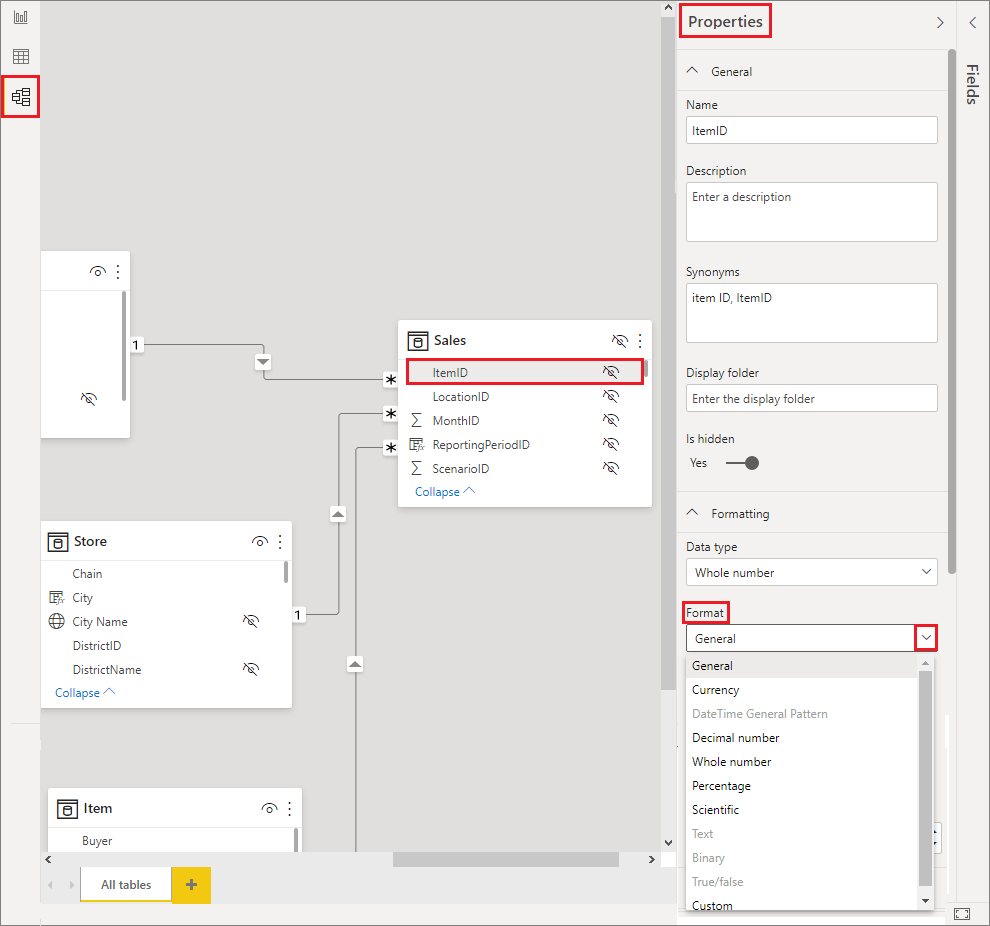
Once you select Custom from the Format dropdown menu, choose from a list of commonly used format strings.
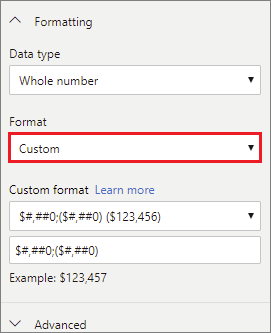
Add a visual level format string
To create a visual level format string, first add the field or visual calculation to your visual. Then, with your visual selected, open the format pane and go to the General section of the format pane. Find the Format data settings and configure the format string there:
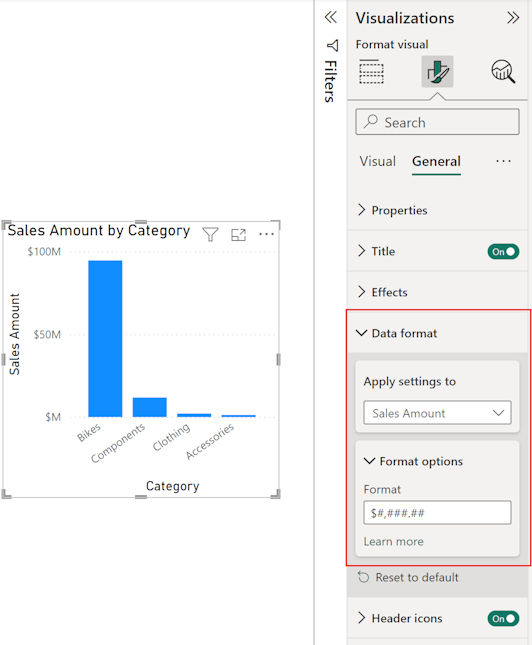
Note
For now, you need to enter a .NET format string instead of a VBA format string. This is a temporary issue that will be resolved in a future release.
Add an element level format string
To create an element level format string, open the format pane and find the format string sections for the element you want to set the format on. Keep in mind that not all elements support format strings. Also, element-level Display units can still apply automatic K/M/B scaling unless you set them to None. To set a format string on a data label, open the Visual section of the format pane, set Data Labels > Value > Display units to custom and enter the format code:
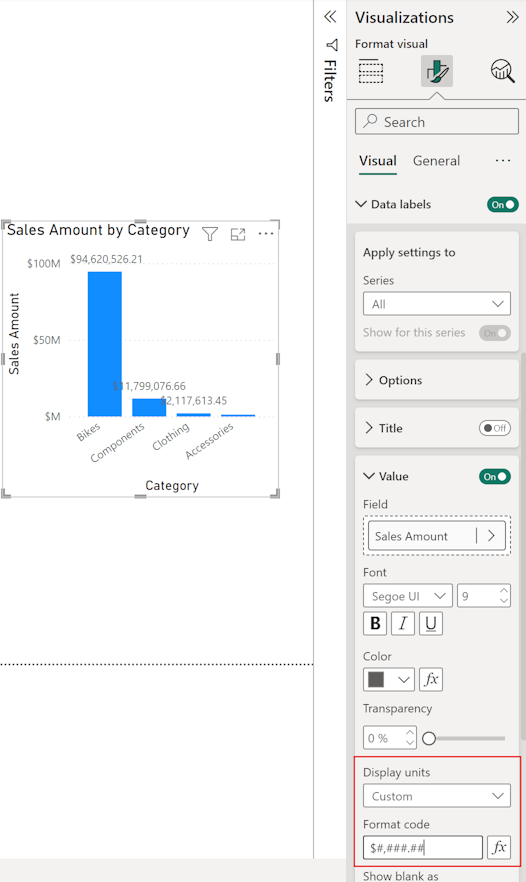
Supported custom format syntax
Custom format strings follow the VBA style syntax, common to Excel and other Microsoft products, but they don't support all syntax used in other products.
Note
Visual level format strings currently use .NET date/time and numeric format tokens (temporary limitation). This means casing matters (M = month, m = minute). Model- and element-level custom format strings use the VBA-style tokens documented in the following tables. This limitation will be removed in a future release so all levels use a unified syntax.
Troubleshooting unexpected month or minute values
If a custom format shows minutes where you expected a month:
- Confirm whether you applied the format at the visual level (currently .NET syntax).
- If so, change
mtoMfor month, or move the custom format string to the model level to use VBA-stylem. - Use
nnfor minutes in VBA-style contexts to avoid confusion with month symbols.
Troubleshooting unwanted automatic scaling (K, M, B suffixes)
If your visual shows a suffix such as K (thousands), M (millions), or B (billions) even though you set a custom number format (for example #.### or #,##0), the suffix usually isn’t coming from the custom format string. It’s applied by the Display units (autoscaling) setting on the visual or element.
Typical causes:
- Display units set to Auto (default) for a card, KPI, gauge, new card, slicer value, or data label.
- Element-level formatting applied, but element’s Display units still autoscale.
- A visual calculation or aggregation readded after changing format (Display units reverted to Auto).
How to remove the K/M/B suffix:
- Select the visual.
- Open the Format pane.
- Locate the numeric value settings (for example General > Data format, Visual > Data labels, Callout value, or Values for the new card).
- Set Display units (sometimes labeled Units or Value units) to None (not Auto).
- Reapply (or confirm) the desired custom format string (for example
#,##0,0,0.0,#,##0.###).
If still present:
- Check for an element-level override (for example data label settings) also set to Auto.
- Confirm you didn’t embed a literal “K” in the custom format (for example
0" K"). - For model-level measures, ensure no DAX logic already scales the value (for example dividing by 1000).
Example comparison:
| Setting | Display units | Custom format | Result |
|---|---|---|---|
| Card visual (default) | Auto | #,##0 |
12K (scaled) |
| Card visual (changed) | None | #,##0 |
11,732 |
| Data label (clustered column) | Auto | 0 |
12K |
| Data label (clustered column) | None | 0 |
11,732 |
| New card (Value formatting) | Auto | 0.0" °C" |
23.4K °C (undesired) |
| New card (Value formatting) | None | 0.0" °C" |
23.4 °C |
Tip
If you want custom abbreviations but not the default K/M/B logic, keep Display units: None and append literal text in the format string (for example 0.0"k"). This preserves raw numeric precision control.
Note
Dynamic scaling based on value size (for example, switching between no suffix, K, and M) requires a measure returning text (for example, using FORMAT() or conditional logic) or a dynamic format string measure. Static custom format strings alone don’t provide conditional suffix logic.
The following tables define the syntax supported in Power BI.
Supported date symbols (VBA-style syntax used by model and element level)
The following symbols apply to custom format strings that use the VBA-style (Excel-like) syntax.
Important
Visual-level custom format strings temporarily require .NET format tokens (see note that follows). In .NET custom date/time formats, uppercase M represents month and lowercase m represents minutes. In VBA-style formats (used at model and element levels here), lowercase m represents month. This difference is a common source of confusion.
| Symbol | Meaning or output |
|---|---|
| d | Day of month without leading zero (1–31). |
| dd | Day of month with leading zero (01–31). |
| m | Month number without leading zero (1–12). If immediately after h or hh, it's interpreted as minutes (see “Minute symbols” that follow). |
| mm | Month number with leading zero (01–12). If immediately after h or hh, it's interpreted as minutes with leading zero (00–59). |
| mmm | Abbreviated month name (Jan–Dec). (Hijri month names have no abbreviations.) |
| mmmm | Full month name (January–December). |
| yy | Two‑digit year (00–99). |
| yyyy | Four‑digit year (0001–9999). |
Note
If you see unexpected minute values where you expect months, confirm whether you entered the format in a visual-level setting (currently .NET style) or a model/element level setting (VBA style).
Supported time symbols (VBA-style)
| Symbol | Meaning or output |
|---|---|
| h | Hour without leading zero (0–23). When combined with AM/PM, represents 1–12. |
| hh | Hour with leading zero (00–23). When combined with AM/PM, represents 01–12. |
| n | Minute without leading zero (0–59). |
| nn | Minute with leading zero (00–59). |
| m / mm | ALSO minutes (0–59 / 00–59) only when they immediately follow h or hh. Otherwise they're treated as month symbols (see date symbols). |
| s | Second without leading zero (0–59). |
| ss | Second with leading zero (00–59). |
Tip
Prefer n / nn for minutes to avoid ambiguity with m / mm month symbols.
Date and time examples
Assume the sample timestamp: 2025-09-04 15:07:08 (September 4, 2025, 3:07:08 PM).
| Format string | Context (VBA-style versus .NET) | Expected output | Notes |
|---|---|---|---|
| m/d/yy | VBA-style (model) | 9/4/25 | Month as number; day no leading zero. |
| mm/dd/yyyy | VBA-style (model) | 09/04/2025 | Leading zeros. |
| mmm d, yyyy | VBA-style (model) | Sep 4, 2025 | Abbreviated month. |
| mmmm d | VBA-style (model) | September 4 | Full month name. |
| h:nn:ss | VBA-style (model) | 15:07:08 | Uses nn to avoid month ambiguity. |
| h:m:s | VBA-style (model) | 15:7:8 | m interpreted as minutes (follows h). |
| m | VBA-style (model) | 9 | Standalone month number. |
| M | .NET visual-level | 9 | In .NET, uppercase M = month. |
| m | .NET visual-level | 07 | In .NET, lowercase m = minutes. |
| mm/dd | Mixed misuse (.NET visual-level) | 07/04 | Shows minutes/day if user expected month/day—source of confusion. |
Note
If you see a minute value (like 07) where you expected a month (like 09), you likely entered a .NET-style format (visual level) thinking it was VBA-style. Adjust the casing (M vs m) or move the formatting to the model level.
Add Unicode or special symbols (degree, currency, superscripts)
Custom format strings don’t support hex or escape sequences (for example \u00B0, 0xB0, or °). To include a symbol, insert (paste/type) the actual Unicode character inside a quoted literal or (for some numeric formats) unquoted if it’s a trailing literal.
| Goal | Format string (model / VBA style) | Output example | Notes |
|---|---|---|---|
| Append Celsius with a space | 0.0" °C" |
23.4 °C |
Space is inside quotes so it’s preserved. |
| Add percent text (not automatic scaling) | 0.00" pct" |
12.34 pct |
Different from % placeholder (which multiplies by 100). |
| Show thousands with KB suffix | 0" KB" |
512 KB |
Literal “KB”. |
| Currency with explicit symbol | #,##0.00" €" |
1,234.00 € |
Prefer locale-based model-level currency if dynamic symbol needed. |
| Microseconds label | 0" µs" |
15 µs |
Paste µ (U+00B5). |
| Degree without trailing unit | 0"°" |
90° |
No space added. |
| Superscript squared | 0" m²" |
25 m² |
Paste ² (U+00B2). |
Tip
To insert a symbol:
- Windows: Press
Win + .(emoji/symbol panel) or use an ALT code (for example, holdAlt, type0176on numeric keypad for °). - Copy/paste from a character map.
Once the literal is in the format string, it’s treated as plain text.
Important
Backslash (\), \uXXXX, or 0xNN escape patterns aren’t interpreted—Power BI doesn’t translate them to Unicode in custom format strings. Use the character itself. For visual-level (.NET) formats the rule is the same: include the actual character inside quotes (for example 0.0" °C"). A backslash only escapes the next character; it doesn’t create Unicode sequences.
Note
For dynamic symbol logic (for example, switching °C / °F based on slicer selection) use a DAX measure returning a text value, or a dynamic format string measure rather than only a static custom format string.
You can see an example of how to format custom value strings.
A user-defined format expression for numbers can have one to three sections separated by semicolons. If you include semicolons with nothing between them, the missing section doesn't display, instead you see "". If you don't specify the semicolon, it uses the positive format.
Here are examples of different formats for different value strings:
| Values | Format String | Format String | Format String | Format String |
|---|---|---|---|---|
| 0.00;-0.0;"Zero" | 0.00;; | 0.00;-0.0; | 0.00; | |
| -1.234 | -1.2 | "" | -1.2 | "" |
| 0 | "Zero" | "" | "" | 0.00 |
| 1.234 | 1.23 | 1.23 | 1.23 | 1.23 |
The following table identifies the predefined named date and time formats:
| Format name | Description |
|---|---|
| General Date | Display a date and time, for example, 4/3/93 05:34 PM. If there's no fractional part, display only a date, for example, 4/3/93. If there's no integer part, display time only, for example, 05:34 PM. Date display is determined by your system settings. |
| Long Date | Display a date according to your system's long date format. |
| Short Date | Display a date using your system's short date format. |
| Long Time | Display a time using your system's long time format; includes hours, minutes, seconds. |
| Short Time | Display a time using the 24-hour format, for example, 17:45. |
Named numeric formats
The following table identifies the predefined named numeric formats:
| Format name | Description |
|---|---|
| General Number | Display number with no thousands separator. |
| Currency | Display number with a thousands separator. Display two digits after the decimal separator. Output is based on system locale settings. |
| Fixed | Display at least one digit before and two digits after the decimal separator. |
| Standard | Display number with a thousands separator, at least one digit before and two digits after the decimal separator. |
| Percent | Display number multiplied by 100 with a percent sign ( % ). Always display two digits after the decimal separator. |
| Scientific | Use standard scientific notation. |
Other date/time formatting characters
The following supplemental characters apply (not already covered):
| Character | Description |
|---|---|
| : | Time separator (locale-specific). |
| / | Date separator (locale-specific). |
| tt | AM/PM designator (12-hour clock, uppercase). |
Note
Other day/month/year/hour/minute/second tokens already defined follow VBA-style semantics at model/element level and .NET semantics (casing-sensitive) at visual level.
The following table identifies characters you can use to create user-defined number formats.
| Character | Description |
|---|---|
| None | Display the number with no formatting. |
| ( 0 ) | Digit placeholder. Display a digit or a zero. If the expression has a digit in the position where the 0 appears in the format string, display it. Otherwise, display a zero in that position. If the number has fewer digits than there are zeros (on either side of the decimal) in the format expression, display leading or trailing zeros. If the number has more digits than there are zeros after the decimal separator, round the number to as many decimal places as there are zeros. If the number has more digits than there are zeros before the decimal separator, display the extra digits without modification. |
| ( # ) | Digit placeholder. Display a digit or nothing. If the expression has a digit in the position where the # appears in the format string, display it; otherwise, display nothing in that position. This symbol works like the zero-digit placeholder. However, leading and trailing zeros don't display if the number has the same or fewer digits than there are # characters on either side of the decimal separator in the format expression. |
| ( . ) | Decimal placeholder. In some locales, a comma is used as the decimal separator. The decimal placeholder determines how many digits are displayed before and after the decimal separator. If the format expression contains only number signs to the left of this symbol, numbers smaller than one begin with a decimal separator. To display a leading zero displayed with fractional numbers, use 0 as the first-digit placeholder to the left of the decimal separator. The actual character used as a decimal placeholder in the formatted output depends on the Number Format recognized by your system. |
| (%) | Percentage placeholder. The expression is multiplied by 100. The percent character ( % ) is inserted in the position where it appears in the format string. |
| ( , ) | Thousands separators. In some locales, a period is used as a thousands separator. The thousands separator separates thousands from hundreds within a number that has four or more places to the left of the decimal separator. Standard use of the thousands separator is specified if the format contains a thousands separator surrounded by digit placeholders ( 0 or # ). Two adjacent thousands separators or a thousands separator immediately to the left of the decimal separator (whether or not a decimal is specified) means "scale the number by dividing it by 1000, rounding as needed." For example, you can use the format string "##0,," to represent 100 million as 100. Numbers smaller than one million are displayed as 0. Two adjacent thousands separators in any position other than immediately to the left of the decimal separator are treated simply as specifying the use of a thousands separator. The actual character used as the thousands separator in the formatted output depends on the Number Format recognized by your system. |
| ( : ) | Time separator. In some locales, other characters might be used to represent the time separator. The time separator separates hours, minutes, and seconds when time values are formatted. The actual character used as the time separator in formatted output is determined by your system settings. |
| ( / ) | Date separator. In some locales, other characters might be used to represent the date separator. The date separator separates the day, month, and year when date values are formatted. The actual character used as the date separator in formatted output is determined by your system settings. |
| ( E- E+ e- e+ ) | Scientific format. If the format expression contains at least one digit placeholder ( 0 or # ) after E-, E+, e-, or e+, the number is displayed in scientific format and E or e is inserted between the number and its exponent. The number of digit placeholders determines the number of digits in the exponent. Use E- or e- to place a minus sign next to negative exponents. Use E+ or e+ to place a minus sign next to negative exponents and a plus sign next to positive exponents. |
| - + $ ( ) | Display these literal characters. Any other Unicode character (°, €, µ, ², etc.) can be included by typing or pasting it inside double quotes (for example 0.0" °C"). Use a backslash only to escape the next character if it would otherwise be interpreted (it doesn’t introduce hex or \u escapes). |
| ( \ ) | Display the next character in the format string. To display a character that has special meaning as a literal character, precede it with a backslash (\). The backslash itself isn't displayed. Using a backslash is the same as enclosing the next character in double quotation marks. To display a backslash, use two backslashes (\\). Date-formatting and time-formatting characters (a, c, d, h, m, n, p, q, s, t, w, /, and :) can't be displayed as literal characters, the numeric-formatting characters (#, 0, %, E, e, comma, and period), and the string-formatting characters (@, &, <, >, !). |
| ("ABC") | Display the string inside the double quotation marks (" "). |
Considerations and limitations
- You can't set a custom format string for fields that are of type string or boolean.
Related content
For more information, see:
